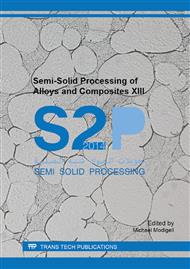p.286
p.294
p.302
p.312
p.318
p.325
p.332
p.340
p.347
Influence of Process Parameters on Surface Appearance and Roughness of a Low Si Containing Al-Alloy, in Semisolid Casting
Abstract:
The visual appearance and surface roughness were experimentally investigated in industrial scale for a low silicon containing aluminium alloy cast in semisolid state integrated with HPDC machine. A visual comparative technique and surface roughness in the form of the Rq value were used to evaluate the surface appearance and the surface roughness respectively. The results were investigated statistically to find significant models. It was shown that high quality appearance, following a comparative scale, was possible using high die temperature and high injection speed. It was also found that improving the surface roughness will deteriorate the visual appearance.
Info:
Periodical:
Pages:
318-324
Citation:
Online since:
September 2014
Price:
Сopyright:
© 2015 Trans Tech Publications Ltd. All Rights Reserved
Share:
Citation:


